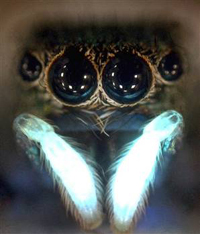Glowing mate puts twinkle in spider's eye
What puts that sexy twinkle in a spider's eye? A mate aglow.

Take away the ultraviolet portion of light, and what seemed like the arachnid version of Scarlett Johansson or Matthew McConaughey attracts no more lust than plain Jane or dumpy Dan.
While people cannot see ultraviolet light, spiders can, and it turns out to be important to their mating, researchers report in this week's online edition of the journal Science.
It seems that both male and female jumping spiders - Cosmophasis umbratica - have markings on their faces and legs that glow in ultraviolet light, researchers led by Daiqin Li at the National University of Singapore reported.
Many animals possess UV vision and use it for foraging, navigation and sexual selection, Li explained.
Jumping spiders are known to have good eyesight, he said, adding that many of these spiders are colorful, with the males generally more colorful than females.
That suggests a possible role of UV vision in jumping spiders, he said, so the researchers decided to explore the possibility.
"But we discovered UV-induced fluorescence communication in jumping spiders by chance," Li said.
"We were hoping to find out whether jumping spiders could really detect UV and respond to it, as well as whether jumping spiders use UV signals in their communications," Li explained.
The team placed pairs of spiders in a variety of light conditions to determine their reactions to each other, the AP writes.
The results:
- Under full-spectrum light, including UV, males and females began courtship rituals such as bent legs and hunched or flexed abdomens.
- Without UV light, females turned away and males ignored the girls or reduced their actions.
- When males were placed in UV light and females were not, the females could see the reflection from the males and performed their normal courting behavior. But 16 of 20 males ignored the females, who were not reflecting UV light.
- And when females were in UV light and males were not, the males responded to the glowing females and began courting behavior, but 10 of the 12 females failed to respond.
"We conclude that sexual coloration is a crucial prerequisite for courtship," Li and his co-authors wrote.
The research was funded by the National University of Singapore Academic Research Fund.
Subscribe to Pravda.Ru Telegram channel, Facebook, RSS!


